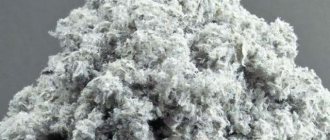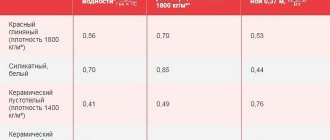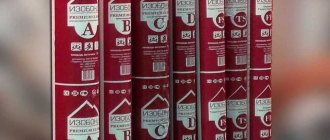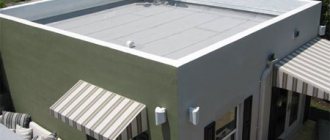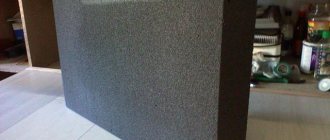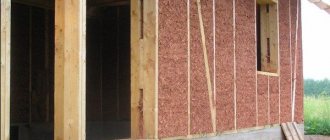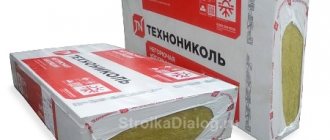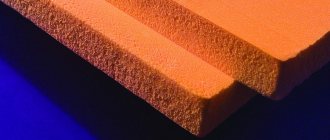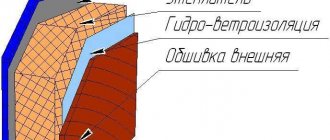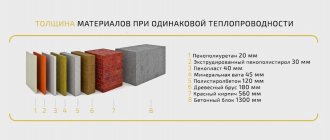Foam glass is a durable, strong and popular material for insulation. It is easy to install and highly efficient. The technology was invented almost a century ago in the USSR, and practical application was invented later in Canada. Foam glass appeared on the building materials market recently, when its production technology made it possible to make it affordable and of high quality. Before use, it is worth considering what granules or foam glass slabs are, their main advantages and disadvantages, as well as methods of use for insulation.
Description and types of foam glass
Foam glass combines the advantages of two materials at once. It combines silicate glass, which is durable and brittle, and foam, an incredibly light material. The production of foam glass involves heating a silicate mass with the addition of a substance that forms a gas. High temperature leads to the melting of the substance, as well as the formation of small bubbles. This technology allows us to obtain a lightweight and durable material that has a high heat resistance.
In the field of thermal insulation, two main types are used:
- Slab foam glass. The insulation is in the form of a plate, which has a structure with closed cells. Ideal for insulating basements, facades, ceilings, floors and foundations. The thickness is 6-12 cm, and the size of the plate is 45*60 cm. They can withstand even significant operating loads, do not shrink and are resistant to deformation under mechanical stress.
Slab insulation
- Granular material. It is a microporous spherical granule. It is produced in granules of various sizes from 1-5 mm to 7-20 mm. Can be used as insulation for interior walls, ceilings and floors.
Granular foam glass
The technical characteristics of the two types of material are similar, so when choosing it you should base only on the convenience and feasibility of using insulation of one form or another.
Types of thermal insulation from foam glass
Foamed glass insulation was developed by a Soviet scientist in the 30s of the 20th century. At that time, the production technology was considered too expensive and the project was postponed indefinitely. And finally, this material has found its application in construction. It is made from glass waste, which is a definite plus.
Broken glass is ground into powder, mixed with a foaming agent (coal, coke, marble, limestone) and brought to a liquid state by heating to 800–900 degrees.
At this temperature, a reaction occurs with the release of carbon dioxide, the bubbles of which are evenly distributed throughout the liquid mass. As a result, after cooling, a solid material with a closed-cell structure is obtained. It looks like hardened soap suds with all the bubbles made of glass. Foamed glass insulation comes in the form of:
- slabs;
- blocks;
- shells;
- granules;
- crushed stone
Foam glass is suitable for insulating walls, floors and horizontal roofs. The material is absolutely environmentally friendly and can be used even in rooms with increased sanitary requirements (hospitals, kindergartens, laboratories, etc.).
A closed heating system in a wooden house is more common, a circuit with an open expansion tank.
How to install heating in a two-story wooden house: vertical or horizontal? The answer is here.
Main characteristics
According to statistics, the higher the hardness of a material, the lower its thermal insulation properties. Foam glass is one of the insulation materials that not only withstand heavy loads, but also have a low thermal conductivity.
Other material characteristics include:
- Thermal conductivity. Foam glass has a thermal conductivity of 0.04 W/m*s. If we compare it with wood, then for this material this indicator is two times lower, and for minimal wool it is higher on average by 25%. Therefore, foam glass perfectly protects against heat loss better than wood, mineral wool and many other insulation materials. High thermal insulation properties are explained by the presence of small closed cells with thin partitions in the structure.
- Strength. A square meter of insulation can withstand pressure of 40-100 tons, and the strength indicator is 0.5-1.2 MPa. This indicator does not deteriorate over time. However, the impact strength of the material is low. Foam glass can be broken under strong mechanical stress.
- Soundproofing. Foam glass can be used effectively not only for protection against heat loss, but also against extraneous noise. The material is capable of dampening sound waves with a force of 45-56 decibels.
- Temperature resistance. The insulation is able to withstand temperatures from -200 to +300 degrees, which allows it to be used even at extreme temperatures.
- Density. This indicator for the material is very low and is equal to 100-250 kg per cubic meter. And this figure is at least three times lower than the density of wood.
- Vapor permeability. Foam glass can also be used as a vapor barrier. The vapor permeability indicator is only 0.005 mg/(m*h*Pa).
- Moisture resistance. Foam glass slabs and granules can absorb no more than 2% of water from their own volume. The material not only does not absorb moisture, but also does not change its properties when interacting with it.
High moisture resistance
- Biological stability. Foam glass has a high resistance to insects, rodents and microorganisms. The insulation does not absorb water, so mold and mildew do not form in it. And the high hardness of the material protects it from insects and rodents.
- Chemical resistance. Foam glass is a chemically inert material. Therefore, when in contact with acids, alkalis, gases and oil products, foam glass does not interact. The only substance with which foam glass interacts is hydrofluoric acid.
- Ecological cleanliness. Foam glass does not burn, does not emit toxic gases and does not produce decay products. This makes the material safe for insulating residential premises.
The unique characteristics of the material are explained by the combination of the properties of silicate glass and gas microcapsules.
Advantages and disadvantages
In addition to good heat and sound insulation characteristics, foam glass has a number of other advantages:
- safety for humans and the environment, no release of harmful substances;
- resistance to temperature changes;
- fire resistance, non-flammability;
- universal forms that allow you to insulate any surface;
- ease of processing, which does not require special skills;
- durability, maintaining the original shape without deformation;
- wide scope of application;
- the material is not subject to corrosion, rotting, damage by rodents or insects;
- when installing foam glass, no additional fasteners are required;
- high sound insulation.
The disadvantage of the heat insulator is its fragile structure. The material is not suitable for compression, which is why it can crack when other structural elements are displaced. Once damaged, foam glass will no longer be able to function as insulation. The large mass of blocks requires careful calculation of the load on the material to avoid cracks.
The disadvantages of foam glass relate to foam glass blocks; crushed foam glass is free of these disadvantages.
The service life of foam glass is much longer than that of other building materials; when dismantling other structural elements, it will be quite difficult to maintain the integrity of the insulation.
Main advantages
Using foam glass as insulation has a number of significant advantages. These include:
- Excellent thermal insulation characteristics. They are explained by the peculiarity of the structure of the material - small closed cells with thin partitions.
- Versatility. The material is universal, therefore it can be used for insulation of facades, roofs, foundations, communications, walls and floors. It can be used even for objects with a high fire hazard.
- Long service life. The material can last more than 100 years without loss of performance. At the same time, it tolerates high and low temperatures well, as well as their sudden changes.
- Good sound insulation properties. A 10 cm layer of insulation can even muffle the sounds of a running tractor engine behind the wall. Therefore, the material can be effectively used not only for protection against heat loss, but also against extraneous noise.
- Easy to install. An ordinary hacksaw can be used to cut slabs; the granules can simply be poured onto the prepared surfaces. The material is incredibly light, so working with it is easy.
- Safety. The material does not emit hazardous compounds, therefore it can be used in public and residential premises.
- Non-flammability. Foam glass does not burn, but only melts at very high temperatures, without releasing toxic components or smoke.
The advantages of foam glass have made it one of the most successful and high-quality materials for insulating floors, roofs, ceilings, basements, walls and other surfaces.
Foam glass: what it is and how it is produced
A similar material was invented back in the thirties of the last century, and its “progenitor” is considered to be academician, physicist-crystallographer Alexander Isaakovich Kitaigorodsky. Initially, foam glass was supposed to be used as a floating material, but in the process of studying its properties it turned out that it has a high degree of sound insulation and low thermal conductivity.
The technology for producing foam glass is quite complex, which makes it impossible to create it yourself. Glass is melted in special furnaces at a temperature of about 1000˚C, after which it is foamed using gases released when coal burns. The resulting mass is laid out in molds and cools naturally, without forced cooling. This is what provides the material with strength and durability.
Foam glass is also produced in the form of granules of various sizes.
Main disadvantages
Despite the obvious advantages of foam glass, when choosing it as insulation, the disadvantages should also be taken into account. These include:
- High price. On the building materials market, foam glass is one of the most expensive insulation materials. This is due to high energy consumption during production. In addition, production requires expensive equipment.
- Low impact strength. The material has a high compressive strength, but is quite brittle. Therefore, with strong impacts, foam glass can crack, and such cracked slabs can no longer be used as insulation.
- Low vapor conductivity. This property of the material is both its advantage and disadvantage. Despite the fact that fungi and mold cannot form in foam glass, the surface it covers does not allow air exchange, so pockets of infection may appear.
Foam glass is a high-quality and modern insulation material for various types of surfaces, however, when choosing it, the disadvantages should also be taken into account.
Details of insulating a house with foam glass can be found in the video:
Characteristic
Bulk heat insulation is used not only for internal surfaces - it can also be used to insulate a room outside. Walls, floor, roof - you can insulate all elements that structurally allow the filling of material.
Loose fill insulation is cheap. Some of its types are simply industrial waste (sawdust) or ready-made natural materials (sand).
The only drawback is hygroscopicity. When wet, it loses its properties.
It is necessary to pay special attention to the hydro- and vapor barrier of its layers. However, the fear of moisture is characteristic to the same extent for all types of thermal insulation.
Application
A special feature of the material is its excellent thermal insulation abilities combined with high strength. Therefore, it can be used to insulate the base, foundation, load-bearing walls and pipelines. The low water absorption rate allows it to be used for thermal insulation of the basement, foundation and ground floor. Granular material can be used as an insulation additive for concrete. To insulate walls, it is enough to pour it into their cavities.
Insulation with granulated foam glass
Foam glass cuts and drills well, so it’s easy to make pieces of the desired size from the slabs. In addition, the slabs hold plaster, putty, glue and other surface finishing compounds well.
The material can be used not only for residential and public premises. It is used for housings of various technological and industrial equipment that operate at high temperatures.
Foam glass insulation
Areas of use
Foam glass blocks are used for external insulation of walls of residential buildings, foundations, agricultural buildings, and buildings for animals. They are actively used in residential development for the implementation of individual projects.
Other areas of use of foam glass:
- thermal insulation of roofs, floors, large-area structures, such as stadiums;
- construction of elements in structures related to water - swimming pools, bathhouses, water parks;
- restoration of old buildings;
- finishing and insulation of basements and other underground structures;
- thermal insulation of buildings in the food and pharmaceutical industries;
- pipeline insulation;
- application in the chemical and oil industries, including in the northern regions;
- thermal protection of furnaces.
Roof insulation
Granules are used for insulation, filling attic floors, cavities inside walls, under floors. Colored foam glass is suitable as a cladding material for buildings and structures. If it is used for finishing or insulation, you will not have to lay a strong foundation for the house, because the total load will not be high.
Important! The material is especially relevant for country houses and buildings located on weak, swampy soils.
Foam glass insulation technology
To guarantee high thermal insulation qualities of the material, it is necessary to follow the technology of its installation:
- To attach the slabs, it is recommended to use special glue, which must be applied to the back of the slab and the side walls. After which the glue should be evenly distributed over the surface of the sheet.
- If the surface has pits, bulges or other irregularities, the adhesive should be applied to the foam glass with slaps to obtain the most even base possible.
- When insulating a wooden base, it is recommended to secure the slabs with special dowels. Wood expands when exposed to moisture and temperature, so insulation must be installed mechanically.
- When installing the slab on a vertical surface, it is necessary to install the bottom strip using a building level. It is best to use a metal profile or rail as a strip.
- The first row of insulation should be mounted on a profile that will act as a support. After the glue has completely hardened, the support can be removed. However, it is best to remove it after the work is completely completed.
- When installing slabs on vertical or inclined surfaces, start from the bottom, and on horizontal surfaces, start from the far corner.
- The slabs should be laid close to each other with one row offset relative to the other. After applying and completely drying the glue, it is additionally recommended to strengthen the slabs with special dowels.
- It is recommended to install heat-insulating boards around windows and doors in one piece. On corner lines, connecting individual pieces of material to each other is not allowed.
Roof insulation with foam glass
Foam glass is a high-quality, modern and very lightweight material for thermal insulation of various surfaces. Proper adherence to installation technology will increase the efficiency of thermal insulation and extend the service life of the material.
House foundation
The two-story house with a total area of 220 m² was built according to. The relatively lightweight design made it possible to use a shallow foundation. Foam glass was used as insulation for it - a material that is not afraid of moisture and fire.
Foam glass is produced both in the form of blocks of different sizes and in the form of crumbs
Foam glass crumbs, which are sold as waste, were also used for a blind area one and a half meters wide.
Construction of the foundation of a house. Foam glass chips were used as insulation
As a result, the foundation of the house also turned out to be energy efficient.
Construction of the foundation of a house.
Rules for thermal insulation of a house with foam glass
Foam glass insulation can be carried out in various rooms, but the methods of its fastening remain the same for all base surfaces and take into account certain rules:
- If the insulation is fixed using a special adhesive, it should be applied to both mating surfaces - foam glass and the base.
- When pasting an insulator onto an uneven surface that has small chips, depressions or cracks, it is advisable to apply the working mixture in splashes. Although this increases its consumption, it guarantees a reliable and durable fastening to the insulation.
- When thermally insulating a base made of wood, it is advisable to fasten the foam glass with special dowels. This is due to the fact that, with temperature fluctuations, lumber is capable of changing shape and size, so slabs rigidly fixed with glue may become deformed during the operation of the coating and cease to correspond to their main purpose.
- Before insulating a façade or other external walls with foam glass, special support profiles are installed around the perimeter of the building at the level of the building’s base, allowing the first row of slabs to be perfectly leveled and thereby ensuring the correct installation of the remaining covering elements. They are removed only after complete polymerization of the glue under the products of the bottom row.
- Foam glass slabs are always installed on walls from bottom to top, the same applies to inclined surfaces.
- All elements of the foam glass coating should be laid tightly to each other, and each overlying row should be located with some offset relative to the lower one to ensure suture ligation and the strength of the insulating layer.
- When using combined fastening of foam glass using glue and dowels, it is recommended to install the latter after pasting and drying of the composition.
- In the locations of openings and other similar structural elements, only solid slabs of foam glass should be installed.
Foam glass installation technologies
Taking into account the rules for fastening foam glass, you can easily and effectively insulate any house structure.
The properties of this material make it possible to abandon the use of traditional moisture and windproof membranes. Let's consider the most common technologies for installing foam glass as insulation for various building elements:
- Insulation of walls under heavy cladding
. In this case, foam glass slabs must be glued to the concrete or brick surface according to the rules described above. After this, you need to perform additional fixation of the material with dowels, 4-5 pieces per slab. Then you should install a metal profile under the stone cladding and install it. - Insulating a wall under plaster
. Here, foam glass slabs need to be glued onto the brickwork or the surface of a wall made of aerated concrete blocks. On top they should be covered with reinforcement mesh with an overlap of 10 cm and secured with umbrella dowels. After this, you can apply the plaster solution to the wall in a layer of up to 30 mm. - Insulation of a wall with brick cladding
. In this case, the base brick surface should be covered with foam glass slabs. Flexible connections are easier to install after installing the insulation. After this, you need to complete the external masonry with facing bricks. Instead of slabs, you can use granulated foam glass, pouring it between the base wall and the cladding as it is installed. The distance between two masonry layers must be at least 250 mm. - Insulation of a wall under a metal profiled sheet
. To do this, the base surface should be covered with foam glass, and on top of it a sheathing made of profiles or wooden slats should be made. Fasteners must be selected taking into account the type of wall material. Profiled sheets are attached to the sheathing along the insulation from bottom to top and overlapping. - Insulation of partitions
. It is practically no different from external wall insulation with foam glass. In this case, the insulation is also covered with a plaster layer. Aluminum profiles must be installed under plasterboard sheets. - Insulation of the roof under waterproofing roll material
. In this case, the concrete floor slab should be treated with a bitumen-polymer liquid composition, then glue or hot bitumen mastic should be applied to the foam glass insulation blocks, and then fixed with gentle pressure on the base surface. After this, the finished coating must be treated with heated bitumen and using a torch, waterproofing and rolled roofing material must be fused onto it. - Insulation of the roof of a house under sheet covering
. In this case, foam glass blocks should be mounted using an adhesive method on a concrete floor. Then the insulation needs to be treated with a bitumen-polymer composition, a roll of insulating material must be fused onto it and a lathing must be made over it to install one or another sheet covering on it. - Insulation of a wooden roof
. Before it is completed, the rafters must be covered with a continuous flooring of boards, and a layer of bitumen-based waterproofing must be laid on top of it. After this, thermal insulation should be made of foam glass and covered with a water-insulating film. After this, you can lay any roofing material. - Floor insulation
. Foam glass slabs need to be tightly laid on top of the base, then covered with two layers of plastic film and filled with cement-sand mortar over the entire structure. After it has set, the floor will be ready for finishing with parquet, linoleum and other materials.
How to insulate a house with foam glass - watch the video:
